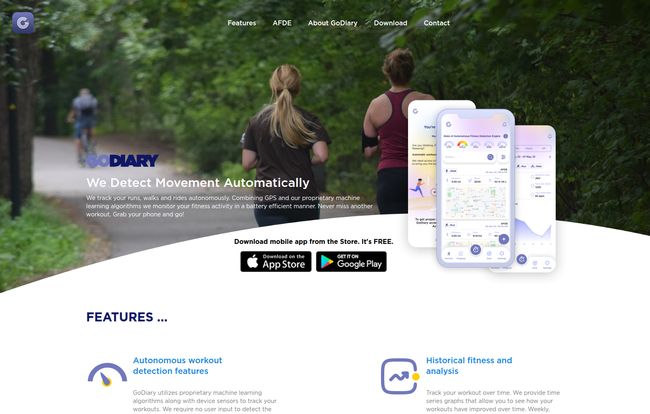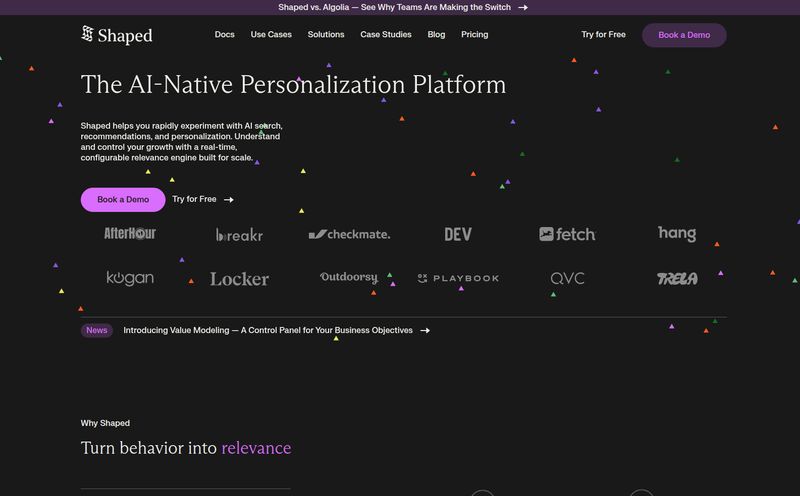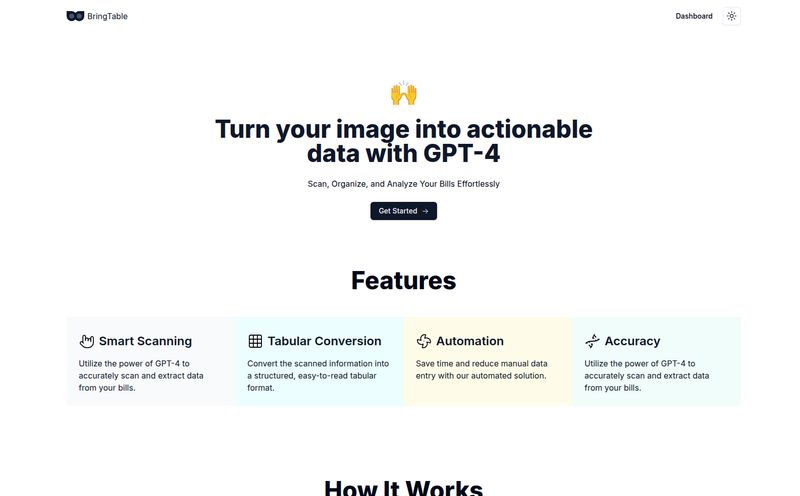We’ve all been there. You lace up your shoes, you’ve got the perfect playlist queued up, the weather is cooperating for once, and you head out for a glorious run. You get back, glowing with that post-exercise high, and reach for your phone to check your stats… only to be greeted by the cold, dead stare of the start screen. You forgot to press the damn button. All those miles, vanished into the ether. A digital ghost.
It’s a uniquely modern frustration, isn't it? In an age of smart everything, we're still tethered to the manual labor of pressing 'start' and 'stop'. For years, I’ve bounced between different tracking apps, and that moment of forgetfulness is a universal pain point. So when I stumbled upon GoDiary, an app that claims to track my runs, walks, and bike rides automatically, my inner skeptic and my lazy inner runner were both intrigued. Could this be the one? The app that just... works?
What Exactly is GoDiary? (And Why Should You Care?)
Let's get the basics out of the way. GoDiary is a fitness app for your phone, but with a crucial twist. Instead of you telling it when you’re starting a workout, it figures it out on its own. It's like having a little personal assistant in your pocket who diligently notes, “Ah, it looks like Bob is going for a run,” and starts logging the data without you ever having to unlock your screen.
It’s designed to pick up on three core activities: walking, running, and cycling. And here’s the kicker that really got my attention: it’s free. Not “free with a million pop-up ads and a crippled feature set,” but actually free to download and use. In a world of endless subscriptions, that’s a pretty bold statement.
The Magic Behind the Curtain: AFDE Explained
So, how does it perform this dark magic? The secret sauce is something they call the Autonomous Fitness Detection Engine, or AFDE. I know, it sounds like something straight out of a sci-fi movie, but it's less 'Skynet' and more 'smart-thermostat'.
Basically, the AFDE uses your phone's built-in sensors—the accelerometer, the GPS, and so on—and feeds that data into a proprietary machine learning algorithm. This algorithm has been trained to recognize the specific patterns of movement associated with walking, running, or riding a bike. It's not watching you 24/7 in a creepy way; it’s just passively monitoring motion data in a very battery-efficient manner. When the patterns match a known activity for a sustained period, it kicks into gear and starts recording. When you stop, it stops. Simple as that.
I've seen similar tech in other platforms, but it's often a premium feature or a notorious battery hog. GoDiary's claim to do this efficiently was the main thing I wanted to put to the test.
My Experience Putting GoDiary to the Test
So, I downloaded it. The setup was straightforward. It asks for a couple of permissions, most notably for your location. And this is the first hurdle for many people: it requires location access to be set to “Always Allow.” More on that later. Once that’s done, you… well, you just go about your day.
It felt weird at first. I went for my usual lunchtime walk, intentionally leaving my phone in my pocket and not opening the app. There was no ceremonial 'start' button to press. It felt… wrong. Like I was breaking a sacred ritual. But sure enough, when I got back to my desk and opened GoDiary, there it was: a 25-minute walk, neatly mapped out with my pace and distance. It was a little bit magical.

Visit GoDiary
It just works in the background of your life, quietly documenting the moments you decide to move.
The next day, I tried it with a run. It picked it up after about a minute or two of jogging and tracked the whole thing. The accuracy was pretty good! Maybe not to the exact foot like my dedicated GPS watch, but for an automatic, free app? I was seriously impressed. It captured the route correctly, the splits were reasonable, and the overall distance was within a negligible margin of error for my casual purposes.
The Features That Actually Matter
Beyond the auto-tracking, there are a few other things that make GoDiary a compelling package. It’s not just a one-trick pony.
Truly Automatic Workout Detection
This is the star of the show. The ability to just go for a walk, a run, or a ride and have it logged is a game-changer for consistency. We all know people who get discouraged when they miss logging a few workouts and then fall off the wagon entirely. GoDiary acts as a safety net. Some might argue that the accuracy isn't perfect, and they're right. On one short walk to the coffee shop, it didn't trigger a recording. My guess is there's a minimum time or intensity threshold. But for intentional workouts, it’s been surprisingly reliable.
Digging Into Your Data
An app is only as good as the data it gives you. GoDiary presents your history in clean, easy-to-read time series graphs. You can see your activity levels over the week, month, or year. It’s not as overwhelmingly detailed as something like Garmin Connect, but it’s perfect for seeing trends at a glance. You can also set simple goals based on time or distance, which is a nice touch for keeping yourself motivated. Are you trying to walk 30 minutes a day, five days a week? You can set that up and see your progress bar fill up.
Seamless Apple Health Integration
For anyone in the Apple ecosystem, this is huge. GoDiary plays nicely with Apple Health, meaning any workout it logs can automatically be synced. This helps fill your Activity Rings, contributes to your overall health metrics, and ensures all your fitness data lives in one centralized, secure place. For me, this is a non-negotiable feature for any fitness app, and GoDiary nails it. It makes the app feel like a native part of the iOS experience.
The Elephant in the Room: Privacy and Battery
Okay, let's talk about that “Always Allow” location permission. It’s the price of admission for the automatic detection feature. The app needs to be able to check your location in the background to know when you've started moving on a route. There’s no way around it.
This will be a deal-breaker for some, and I get it. Privacy is a massive concern. GoDiary’s privacy policy seems pretty standard, but you're still placing a degree of trust in the company. For me, the convenience was worth the trade-off, especially since my phone is already tracking my location for a dozen other reasons (hello, Google Maps).
As for battery life? I was watching it like a hawk. I expected a noticeable drain, but honestly, I couldn't tell the difference. Their claim of using battery-efficient algorithms seems to hold up. I didn’t find myself scrambling for a charger any earlier than usual, which was a pleasant surprise.
GoDiary Pricing: How Much Does It Cost?
This section is going to be incredibly short. GoDiary is free. As of this writing, there are no subscription tiers, no premium unlocks, no in-app purchases. You download it, and you get all the features. Given what competitors charge for automatic tracking, this provides some incredible value. I do wonder if they'll introduce a 'Pro' version down the line, but for now, it's one of the most capable free trackers I've ever used.
Who is GoDiary Actually For?
This app isn't going to replace the high-end tools for every athlete. So who is the ideal user?
- The Casual Exerciser: The person who walks their dog, goes for spontaneous bike rides, or jogs a few times a week without a strict training plan.
- The Forgetful Tracker: If you're like me and have a history of forgetting to start or stop your workout logs, this app is your new best friend.
- The Data Minimalist: Someone who wants a record of their activity without being overwhelmed by charts, graphs, and a billion different metrics.
Who is it not for? The elite marathoner or cyclist who needs second-by-second accuracy, manual lap controls, and advanced performance analytics. This tool is about convenience and consistency, not elite-level training analysis. And that's perfectly okay.
Frequently Asked Questions about GoDiary
- 1. Does GoDiary work on Android phones?
- Yes! The website shows download links for both the Apple App Store and the Google Play Store, so it's available for both iOS and Android users.
- 2. Do I really have to keep my location on "Always"?
- For the automatic detection to work, yes. The app needs to be able to monitor your movement in the background to identify when a workout starts. If you turn this permission off, the app will function as a manual tracker, requiring you to start and stop activities yourself.
- 3. How accurate is the automatic tracking?
- In my experience, it's very good for a free, automatic tool. It might not be as precise as a dedicated, high-end GPS watch, and it might miss very short or low-intensity activities. But for most standard walks, runs, and rides, it does a great job.
- 4. Is GoDiary actually free? Are there hidden costs?
- As of my review, GoDiary is completely free to download and use. There are no subscriptions or in-app purchases required for the features I've discussed.
- 5. What happens if I turn off the Autonomous Fitness Detection Engine (AFDE)?
- If you disable the AFDE in the settings, GoDiary will stop tracking your workouts automatically. It will then behave like a more traditional fitness app, where you will need to manually press start and stop to record any activity.
Final Thoughts: Is GoDiary Worth the Download?
After spending some real time with it, I've come away pretty impressed. GoDiary solves a genuine, common problem in a simple and elegant way. It removes the friction from fitness tracking. It's not trying to be the most feature-packed app on the market; it’s trying to be the most effortless one.
The trade-off is the always-on location permission, which is a valid concern. But if you can make peace with that, you get a powerful, automatic, and completely free fitness diary that works silently in your pocket. For anyone who has ever felt the sting of a forgotten workout log, GoDiary isn’t just a cool app—it’s a sigh of relief. It's definitely earned a permanent spot on my phone.



